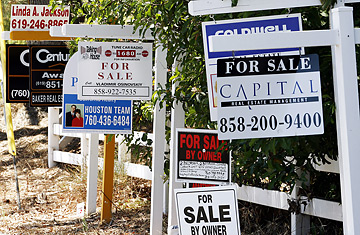
Houses for sale in Southern California
If Wall Street wants to get even more worried about the real estate market, it need look no further than southern California. There, the culprits aren't just the bad-credit borrowers whom banks and lenders loaded up with ballooning debt to purchase their dream homes. The well-to-do have partaken of those treacherous loans as well. And now everyone is hard-pressed to pay as interest rates rise.
Up to now, the booming housing markets in Los Angeles, San Diego and Orange counties had barely felt the chill that hit Miami and Denver from rising inventories, declining prices and slowing sales. But this week's spate of gloomy housing data included ominous reports from the West Coast. Led by an astonishing 799% rise in Los Angeles County, foreclosures in southern California jumped 725% in the second quarter, to a record 9,504, from 1,152 a year ago. The spectacularly bad trend was coupled with news from mega-mortgage lender Countrywide Financial that homeowners with good credit are starting to fall behind on mortgage payments. It has all contributed to a contagiously pessimistic mood. "We thought the upper end of the market was immune," says Steve Johnson, of real estate consulting firm Metrostudy. "But this is now like kudzu in the South, spreading into all product types in the southern California housing market."
The statistics show that subprime-caliber borrowers weren't the only takers for those notorious no-money-down, interest-only, adjustable-rate mortgages. Purchasers with high credit scores, who could have qualified for the standard 30-year mortgages, were also enticed by the exotic loans because they offered substantial initial tax deductions and freed up cash for other big-ticket purchases. "Why pull your money out of the bank for a down payment when someone is willing to give you all the money and structure payments that initially are significantly lower?" asks Johnson. With home values increasing by double digits annually, "people began buying houses they couldn't afford under the theory that the more house you buy, the more wealth you have once it appreciates," he says. "It's kind of a Ponzi scheme on a mass scale. But there has to be an end at some point."
Bill Santoro, a broker with National Realty Group, has watched the end come for many clients, and it isn't pretty. "Once those introductory rates end, all of a sudden between the mortgage, the new car note and the big charge card payments, there's not enough money in the pot," he says. "It throws them into a complete tailspin."
Santoro's territory, known as the Inland Empire, lies some 60 miles east of downtown Los Angeles. When the real estate boom started at the beginning of the decade, the Empires Riverside and San Bernardino Counties stood as monuments to the American dream, affordable nesting spots for those priced out of the L.A. market. Migrant Angelenos found bigger homes on bigger lots in brand new subdivisions for as much as $100,000 less. Johnson says that in some of those developments, as many as 80% of the buyers were subprime borrowers and many of them first-time homeowners. Consequently, when interest rates started to rise, they were squeezed hard. Now the region is a symbol of the real estate slump.
Foreclosures in San Bernardino shot up 987% to 1,489 in the second quarter. In Riverside they jumped 793% to 2,509. That stock will soon be competing with a 13-month supply of unsold inventory that's already on the market. Santoro is braced for the worst. "There's a tsunami coming and we're going to get slammed," he says. And while economics is always local, economic nervousness can go national — even global — in a matter of hours, as recent financial events have shown.
Could the Inland Empire's contagion debilitate L.A. and areas beyond? So far, property experts are still trying to put a positive spin to it. John Karevoll of DataQuick, a company that compiles real estate information, points out that the Los Angeles County foreclosure figure is still well off that regions previous peak of 11,494 recorded in the third quarter of 1996, during southern Californias last real estate collapse. And he's encouraged that activity at the very high end of the L.A. market hasnt fallen off, that home prices in the county overall continue to rise and that job growth is "pretty good." Still, even he admits that the subprime crash has plunged the entire real estate sector into uncharted territory. "Will it create a flood of foreclosures that drags down values in the rest of the market? So far it hasn't, but at some point, it might."
